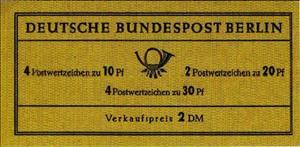Booklet: Booklet-Brandenburger Tor (Berlin 1966)
Booklet-Brandenburger Tor (Berlin 1966)
13 December (Berlin ) within release Brandenburg Gate goes into circulation Booklet Booklet-Brandenburger Tor face value 2 German mark
| Booklet Booklet-Brandenburger Tor in catalogues | |
|---|---|
| Michel: | Mi: DE-BE MH5c RLV II |
Booklet is square format.
with Michel Nr. HB13 RLV II RLV=edge strips variant of Booklet Pane Front cover: black on light brown yellow 1th cover Side: "Inhalt" 2nd cover side: "Michel Katalog" 3rd cover side: "Versandstelle für Sammlermarken" 4th cover side: "Reklame-Schneider"Also in the issue Brandenburg Gate:
- Booklet Pane - Stamp sheet face value 200;
- Se-tenant - Brandenburg Gate face value 60;
- Se-tenant - Brandenburg Gate face value 2*10;
- Se-tenant - Brandenburg Gate face value 30;
- Se-tenant - Brandenburg Gate face value 50;
- Booklet - Booklet-Brandenburger Tor face value 2;
- Booklet - Booklet-Brandenburger Tor face value 2;
- Se-tenant - Brandenburg Gate face value 2*30;
- Booklet Pane - Booklet Pane-Brandenburg Gate, Berlin face value 200;
- Booklet Pane - Booklet Pane-Brandenburg Gate, Berlin face value 200;
- Booklet Pane - Booklet Pane-Brandenburg Gate, Berlin face value 200;
- Booklet Pane - Booklet Pane-Brandenburg Gate, Berlin face value 200;
- Booklet Pane - Booklet Pane-Brandenburg Gate, Berlin face value 200;
- Booklet Pane - Booklet Pane-Brandenburg Gate, Berlin face value 200;
- Booklet Pane - Booklet Pane-Brandenburg Gate, Berlin face value 200;
- Booklet Pane - Booklet Pane-Brandenburg Gate, Berlin face value 200;
- Booklet Pane - Booklet Pane-Brandenburg Gate, Berlin face value 200;
- Full Pane - Brandenburg Gate, Berlin face value 40;
- Full Pane - Brandenburg Gate, Berlin face value 40;
- Booklet - Booklet-Brandenburger Tor face value 2;
- Booklet - Booklet-Brandenburger Tor face value 2;
- Booklet - Booklet-Brandenburger Tor face value 2;
- Booklet - Booklet-Brandenburger Tor face value 2;
- Booklet - Booklet-Brandenburger Tor face value 2;
- Booklet - Booklet-Brandenburger Tor face value 2;
- Booklet - Booklet-Brandenburger Tor face value 2;
- Booklet - Booklet-Brandenburger Tor face value 2;
- Booklet - Booklet-Brandenburger Tor face value 2;
- Booklet - Booklet-Brandenburger Tor face value 2;
- Booklet - Booklet-Brandenburger Tor face value 2;
- Booklet - Booklet-Brandenburger Tor face value 2;
- Booklet - Booklet-Brandenburger Tor face value 2;
- Booklet - Booklet-Brandenburger Tor face value 2;
- Booklet - Booklet-Brandenburger Tor face value 2;
- Booklet - Booklet-Brandenburger Tor face value 2;
- Booklet - Booklet-Brandenburger Tor face value 2;
- Booklet - Booklet-Brandenburger Tor face value 2;
- Booklet - Booklet-Brandenburger Tor face value 2;
- Booklet - Booklet-Brandenburger Tor face value 2;
- Booklet - Booklet-Brandenburger Tor face value 2;
- Booklet - Booklet-Brandenburger Tor face value 2;
- Booklet - Booklet-Brandenburger Tor face value 2;
- Booklet - Booklet-Brandenburger Tor face value 2;
- Booklet - Booklet-Brandenburger Tor face value 2;
- Booklet - Booklet-Brandenburger Tor face value 2;
- Booklet - Booklet-Brandenburger Tor face value 2;
- Booklet - Booklet-Brandenburger Tor face value 2;
- Booklet - Booklet-Brandenburger Tor face value 2;
- Booklet - Booklet-Brandenburger Tor face value 2;
Booklet Booklet-Brandenburger Tor it reflects the thematic directions:
An aircraft (pl. aircraft) is a vehicle that is able to fly by gaining support from the air. It counters the force of gravity by using either static lift or the dynamic lift of an airfoil, or, in a few cases, direct downward thrust from its engines. Common examples of aircraft include airplanes, rotorcraft (including helicopters), airships (including blimps), gliders, paramotors, and hot air balloons.Part 1 (Definitions and Abbreviations) of Subchapter A of Chapter I of Title 14 of the U. S. Code of Federal Regulations states that aircraft "means a device that is used or intended to be used for flight in the air."
A building or edifice is a structure with a roof and walls standing more or less permanently in one place, such as a house or factory. Buildings come in a variety of sizes, shapes and functions, and have been adapted throughout history for a wide number of factors, from building materials available, to weather conditions, to land prices, ground conditions, specific uses and aesthetic reasons. Buildings serve several needs of society – primarily as shelter from weather, security, living space, privacy, to store belongings, and to comfortably live and work. A building as a shelter represents a physical division of the human habitat (a place of comfort and safety) and the outside (a place that at times may be harsh and harmful).
Gates is the plural of gate, a point of entry to a space which is enclosed by walls.
A monument is a type of structure that was explicitly created to commemorate a person or event, or which has become relevant to a social group as a part of their remembrance of historic times or cultural heritage, due to its artistic, historical, political, technical or architectural importance. Examples of monuments include statues, (war) memorials, historical buildings, archaeological sites, and cultural assets. If there is a public interest in its preservation, a monument can for example be listed as a UNESCO World Heritage Site. The Palgrave Encyclopedia of Cultural Heritage and Conflict gives the next definition of monument:



